Magnetic Pycnoporus sanguineus-Loaded Alginate Composite Beads for Removing Dye from Aqueous Solutions
Abstract
:1. Introduction
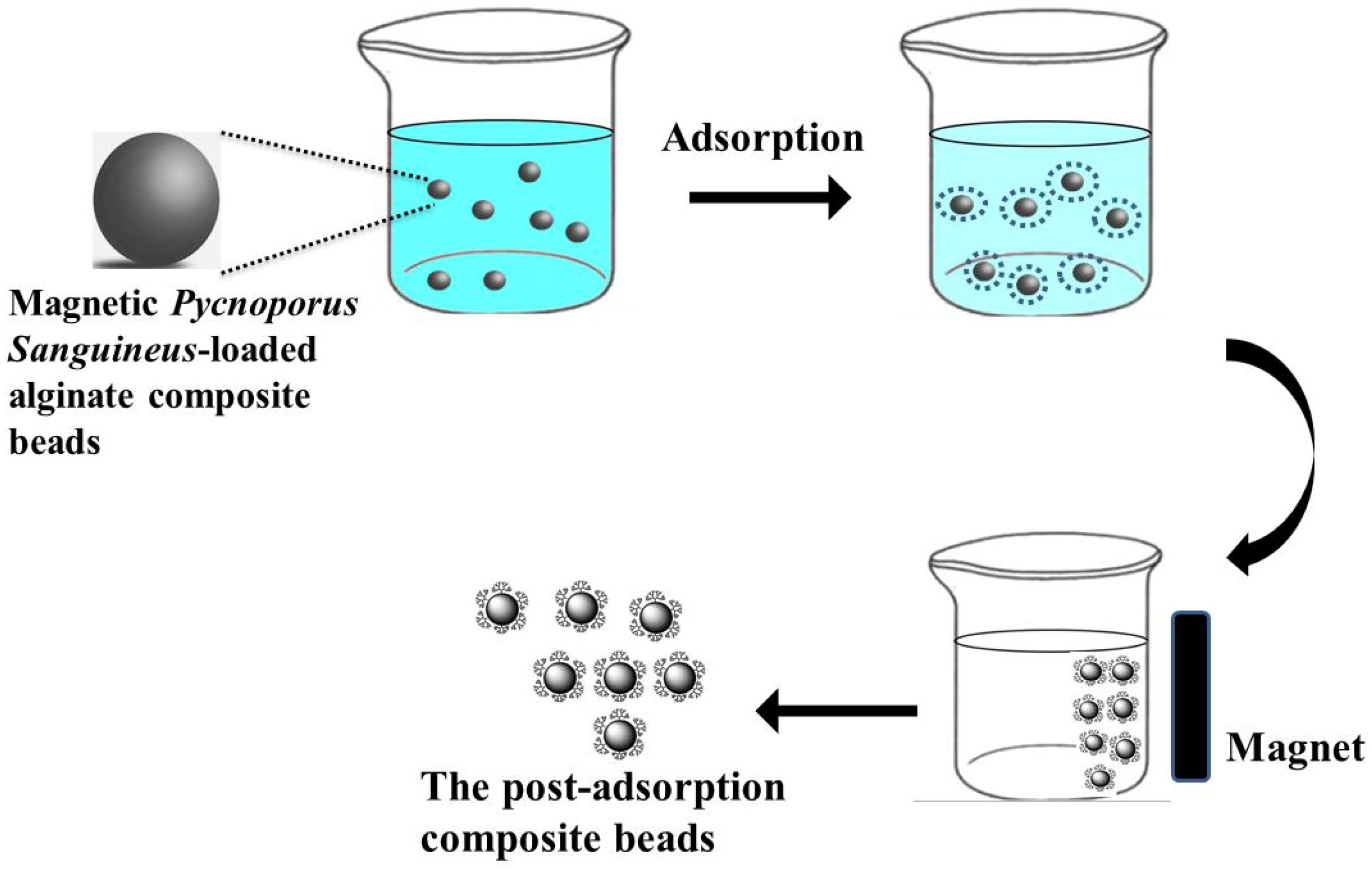
2. Results and Discussion
2.1. Characterization of Magnetic P. sanguineus-Loaded Alginate Composite Beads
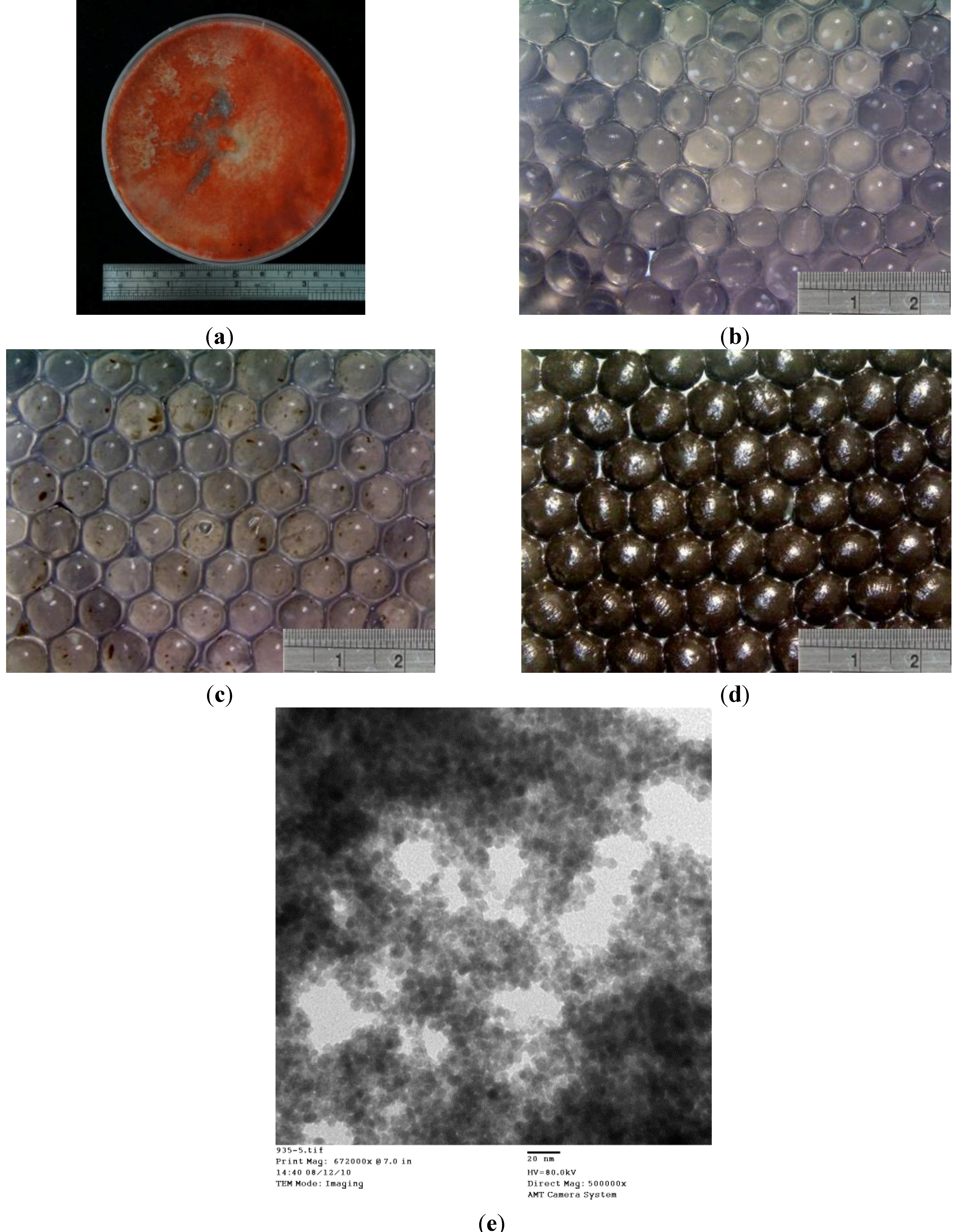
2.2. Removal of Dye from an Aqueous Solution
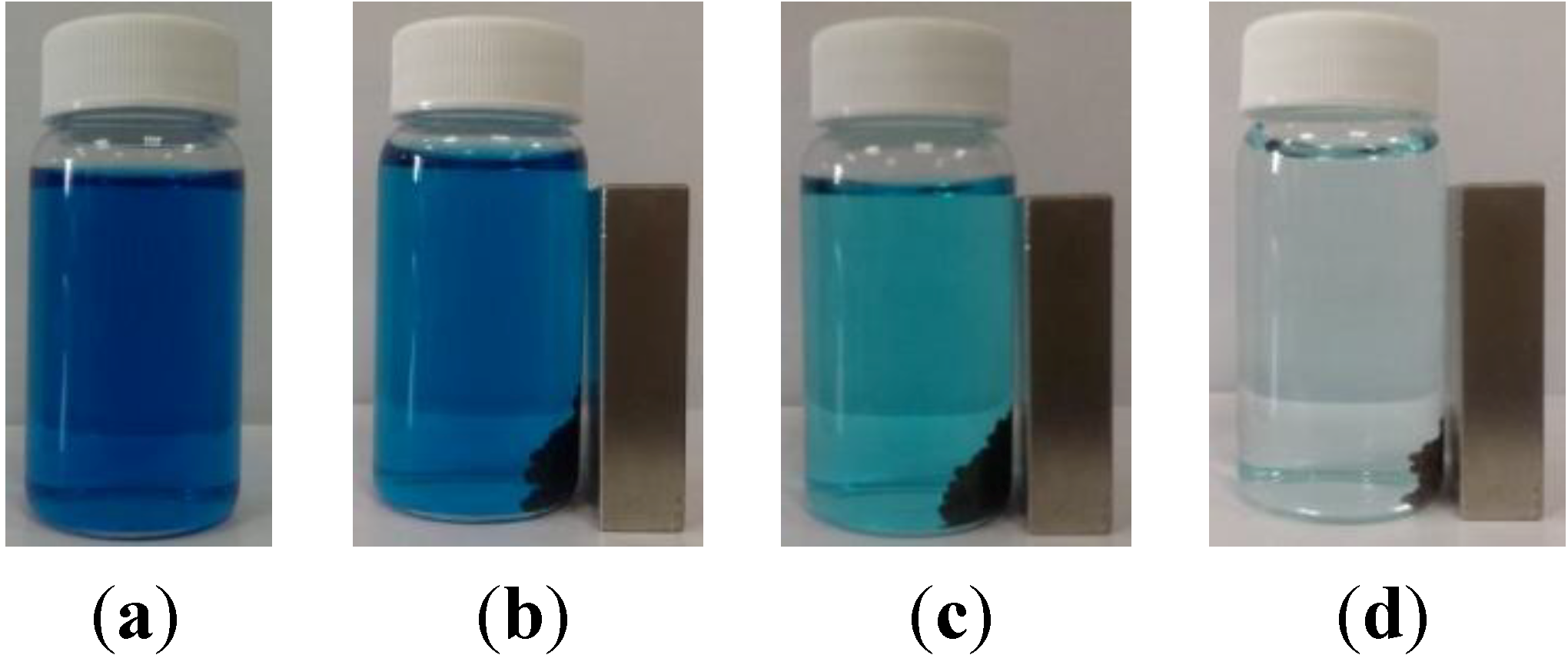
2.3. Effect of Initial Dye Concentration and Contact Time

2.4. Effect of pH on Adsorption

2.5. Kinetics Studies
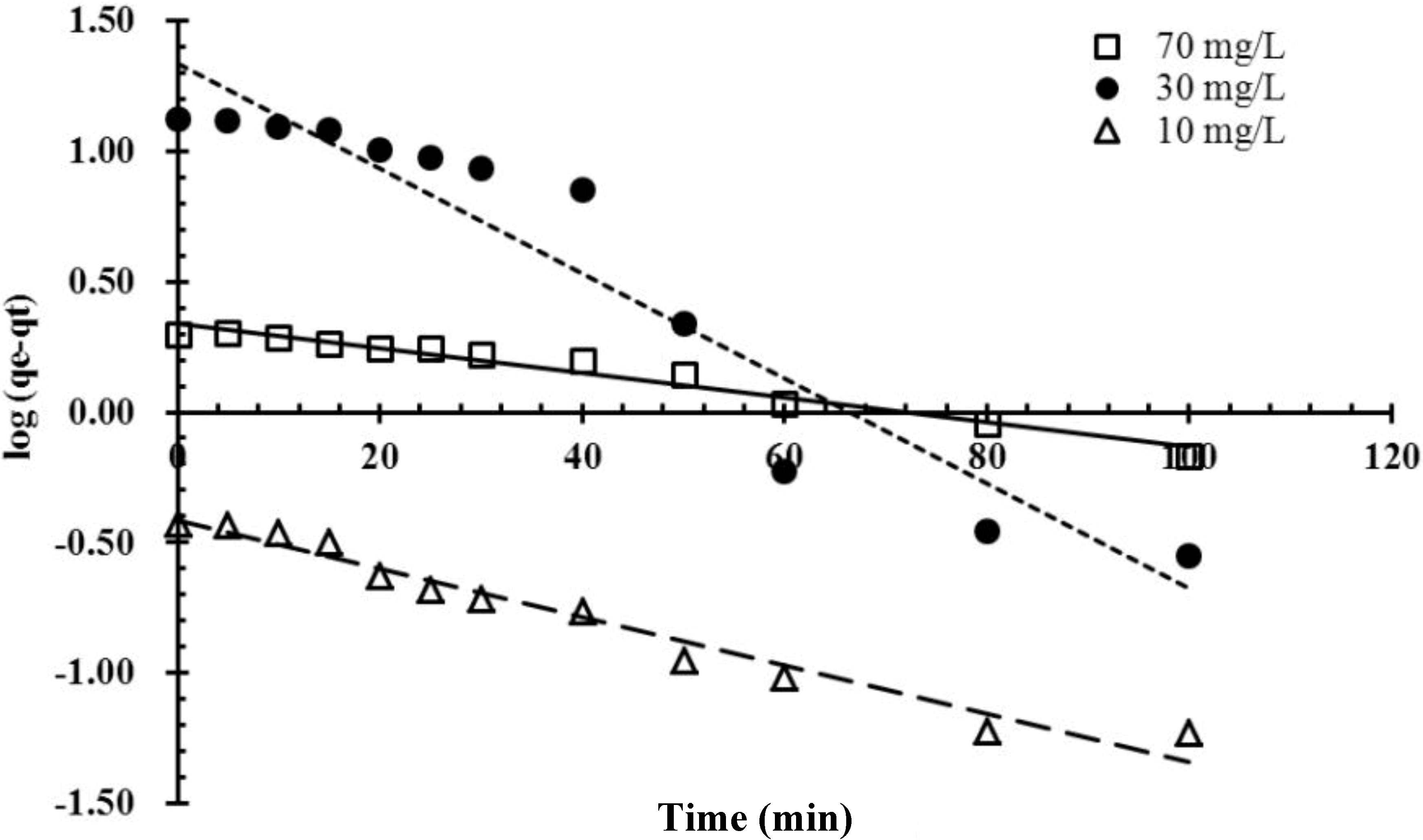
| Co mg/L | T (K) | Pseudo-First-Order | ||
|---|---|---|---|---|
| K1 | qe | R2 | ||
| 70 | 298 | 0.080 | 1.40 | 0.981 |
| 30 | 298 | 0.045 | 0.26 | 0.912 |
| 10 | 298 | 0.024 | 0.68 | 0.991 |
| Co mg/L | T (K) | Pseudo-Second-Order | ||
|---|---|---|---|---|
| K2 | qe | R2 | ||
| 70 | 298 | 0.004 | 2.214 | 0.984 |
| 30 | 298 | 0.242 | 0.275 | 0.760 |
| 10 | 298 | 0.023 | 0.420 | 0.928 |
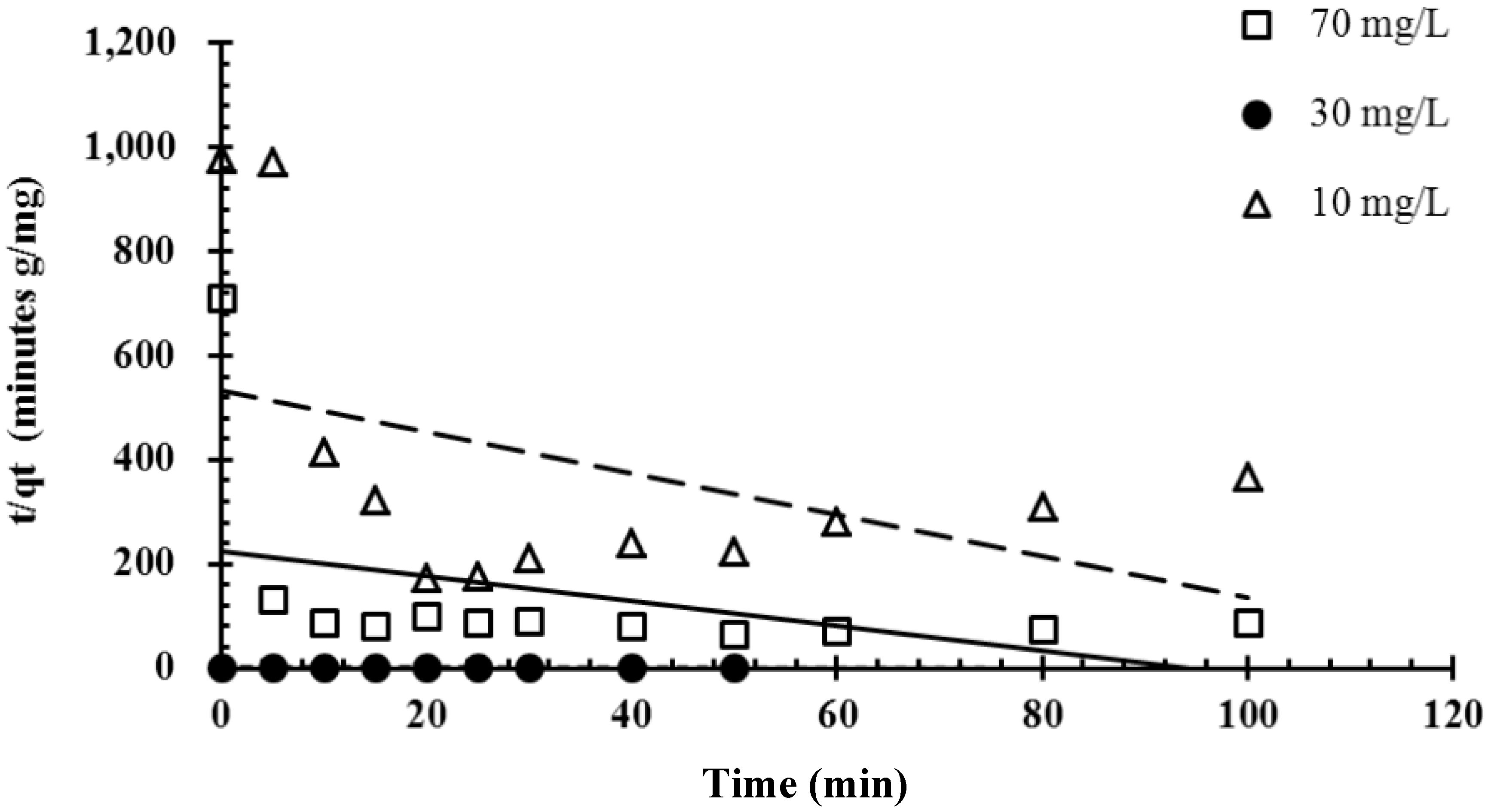
3. Experimental
3.1. Microorganism and Production Medium
3.2. Preparation of Iron Oxide Nanoparticles
3.3. Preparation of Calcium-Alginate Beads
3.4. Preparation of Magnetic P. sanguineus-Loaded Alginate Composite Beads
3.5. Preparation of Dye Solutions
3.6. Kinetic Studies
3.6.1. Pseudo-First-Order Kinetic Model


3.6.2. Pseudo-Second-Order Kinetic Model



 is the intercept.
is the intercept.4. Conclusions
Acknowledgments
Author Contributions
Conflicts of Interest
References
- Kabir, M.; Daly, E.; Maggi, F. A review of ion and metal pollutants in urban green water infrastructures. Sci. Total Environ. 2014, 470, 695–706. [Google Scholar] [CrossRef]
- Yang, H.; Flower, R.J.; Thompson, J.R. Pollution: China’s new leaders offer green hope. Nature 2013, 493, 163–163. [Google Scholar]
- Maurya, N.S.; Mittal, A.K.; Cornel, P.; Rother, E. Biosorption of dyes using dead macro fungi: Effect of dye structure, ionic strength and pH. Bioresour. Technol. 2006, 97, 512–521. [Google Scholar] [CrossRef]
- Rodríguez Couto, S. Dye removal by immobilised fungi. Biotechnol. Adv. 2009, 27, 227–235. [Google Scholar] [CrossRef]
- Mahmoodi, N.M. Magnetic ferrite nanoparticle–alginate composite: Synthesis, characterization and binary system dye removal. J. Taiwan Inst. Chem. Eng. 2013, 44, 322–330. [Google Scholar] [CrossRef]
- Rocher, V.; Siaugue, J.M.; Cabuil, V.; Bee, A. Removal of organic dyes by magnetic alginate beads. Water Res. 2008, 42, 1290–1298. [Google Scholar]
- Alexandru, M.G.; Bogdan, S.V.; Alina, M.H. Eugenol functionalized magnetite nanostructures used in anti-infectious therapy. Lett. Appl. Nanobiosci. 2013, 2, 120–123. [Google Scholar]
- Cotar, A.I.; Grumezescu, A.M.; Huang, K.S.; Voicu, G.; Chifiriuc, C.M.; Radulescu, R. Magnetite nanoparticles influence the efficacy of antibiotics against biofilm embedded Staphylococcus aureus cells. Biointerface Res. Appl. Chem. 2013, 3, 559–565. [Google Scholar]
- Grumezescu, A.M.; Andronescu, E.; Ficai, A.; Ficai, D.; Huang, K.S.; Gheorghe, I.; Chifiriuc, C.M. Water soluble magnetic biocomposite with potential applications for the antimicrobial therapy. Biointerface Res. Appl. Chem. 2012, 2, 469–475. [Google Scholar]
- Mihaiescu, D.E.; Hoeja, M.; Gheorghe, I.; Fical, A.; Grumezescu, A.M.; Bleotu, C.; Chifiriuc, C.M. Water soluble magnetite nanoparticles for antimicrobial drugs delivery. Lett. Appl. Nanobiosci. 2012, 1, 45–49. [Google Scholar]
- Andronescu, E.; Grumezescu, A.M.; Ficai, A.; Gheorghe, I.; Chifiriuc, M.; Mihaiescu, D.E.; Lazar, V. In vitro efficacy of antibiotic magnetic dextran microspheres complexes against staphylococcus aures and pseudomonas aeruginosa strains. Biointerface Res. Appl. Chem. 2012, 2, 332–338. [Google Scholar]
- LeSage, D.; Arai, K.; Glenn, D.R.; DeVience, S.J.; Pham, L.M.; Rahn, L.L.; Lukin, M.D.; Yacoby, A.; Komeili, A.; Walsworth, R.L. Optical magnetic imaging of living cells. Nature 2013, 496, 486–489. [Google Scholar] [CrossRef]
- Mura, S.; Nicolas, J.; Couvreur, P. Stimuli-responsive nanocarriers for drug delivery. Nat. Mater. 2013, 12, 991–1003. [Google Scholar] [CrossRef]
- Ahrens, E.T.; Bulte, J.W. Tracking immune cells in vivo using magnetic resonance imaging. Nat. Rev. Immunol. 2013, 13, 755–763. [Google Scholar] [CrossRef]
- Deans, J.R.; Dixon, B.G. Uptake of Pb2+ and Cu2+ by novel biopolymers. Water Res. 1992, 26, 469–472. [Google Scholar] [CrossRef]
- Davis, T.A.; Volesky, B.; Mucci, A. A review of the biochemistry of heavy metal biosorption by brown algae. Water Res. 2003, 37, 4311–4330. [Google Scholar] [CrossRef]
- Idris, A.; Ismail, N.S.M.; Hassan, N.; Misran, E.; Ngomsik, A.-F. Synthesis of magnetic alginate beads based on maghemite nanoparticles for Pb(II) removal in aqueous solution. J. Ind. Eng. Chem. 2012, 18, 1582–1589. [Google Scholar] [CrossRef]
- Yahaya, Y.A.; Don, M.M.; Bhatia, S. Biosorption of copper (II) onto immobilized cells of pycnoporus sanguineus from aqueous solution: Equilibrium and kinetic studies. J. Hazard. Mater. 2009, 161, 189–195. [Google Scholar] [CrossRef]
- Pointing, S.; Vrijmoed, L. Decolorization of azo and triphenylmethane dyes by pycnoporus sanguineus producing laccase as the sole phenoloxidase. World. J. Microbiol. Biotechnol. 2000, 16, 317–318. [Google Scholar] [CrossRef]
- Bayramoğlu, G.; Bektaş, S.; Arıca, M.Y. Biosorption of heavy metal ions on immobilized white-rot fungus trametes versicolor. J. Hazard. Mater. 2003, 101, 285–300. [Google Scholar] [CrossRef]
- Ting, Y.P.; Sun, G. Use of polyvinyl alcohol as a cell immobilization matrix for copper biosorption by yeast cells. J. Chem. Technol. Biotechnol. 2000, 75, 541–546. [Google Scholar] [CrossRef]
- Aksu, Z.; Gönen, F. Biosorption of phenol by immobilized activated sludge in a continuous packed bed: Prediction of breakthrough curves. Process Biochem. 2004, 39, 599–613. [Google Scholar] [CrossRef]
- Bauer, A.; Layh, N.; Syldatk, C.; Willetts, A. Polyvinyl alcohol-immobilized whole-cell preparations for the biotransformation of nitriles. Biotechnol. Lett. 1996, 18, 343–348. [Google Scholar]
- Yesilada, O.; Asma, D.; Cing, S. Decolorization of textile dyes by fungal pellets. Process Biochem. 2003, 38, 933–938. [Google Scholar] [CrossRef]
- Annuar, M.; Adnan, S.; Vikineswary, S.; Chisti, Y. Kinetics and energetics of azo dye decolorization by pycnoporus sanguineus. Water Air Soil Pollut. 2009, 202, 179–188. [Google Scholar] [CrossRef]
- Tiberto, P.; Barrera, G.; Celegato, F.; Coïsson, M.; Chiolerio, A.; Martino, P.; Pandolfi, P.; Allia, P. Magnetic properties of jet-printer inks containing dispersed magnetite nanoparticles. Eur. Phys. J. B 2013, 86. [Google Scholar] [CrossRef]
- Arica, M.Y.; Kaçar, Y.; Genç, Ö. Entrapment of white-rot fungus trametes versicolor in Ca-alginate Beads: Preparation and biosorption kinetic analysis for cadmium removal from an aqueous solution. Bioresour. Technol. 2001, 80, 121–129. [Google Scholar] [CrossRef]
- Ho, Y.S.; McKay, G. Pseudo-second order model for sorption processes. Process Biochem. 1999, 34, 451–465. [Google Scholar] [CrossRef]
- Chih, H.Y.; Chih, Y.W.; Keng, S.H.; Chao, P.K.; Yi, C.C.; Jei, F.S. Microfluidic one-step synthesis of Fe3O4-chitosan composite particles and their applications. Int. J. Pharm. 2014, 463, 155–160. [Google Scholar] [CrossRef]
- Chih, Y.W.; Chih, H.Y.; Keng, S.H.; Fang, R.C.; Andrew, H.J.W.; Chih, H.C. Electrostatic droplets assisted in-situ synthesis of superparamagnetic chitosan microparticles for magnetic-responsive controlled drug release and copper ion removal. J. Mater. Chem. B 2013, 1, 2205–2212. [Google Scholar]
- Chih, H.Y.; Chih, Y.W.; Keng, S.H.; Chen, S.Y.; Andrew, H.J.W.; Wei, T.W.; Ming, Y.L. Facile synthesis of radial-like macroporous superparamagnetic chitosan spheres with in-situ co-precipitation and gelation of ferro-gels. PLoS One 2012, 7, e49329. [Google Scholar]
- Keng, S.H.; Chih, H.Y.; Chao, P.K.; Ming, D.K.; Alexandru, M.G.; Yung, S.L.; Chih, Y.W. Synthesis of uniform core-shell gelatin-alginate microparticles as intestine-released oral delivery drug carrier. Electrophoresis 2014, 35, 330–336. [Google Scholar] [CrossRef]
- Keng, S.H.; Yung, S.L.; Wan, R.C.; Yi, L.W.; Chih, H.Y. A facile fabrication of alginate microbubbles using a gas foaming reaction. Molecules 2013, 18, 9594–9602. [Google Scholar] [CrossRef]
- Keng, S.H.; Yang, C.H.; Lin, Y.S.; Wang, C.Y.; Lu, K.; Chang, Y.F.; Wang, Y.L. Electrostatic droplets assisted synthesis of alginate microcapsules. Drug Deliv. Transl. Res. 2011, 1, 289–298. [Google Scholar]
- Keng, S.H.; Yung, S.L.; Chih, H.Y.; Chia, W.T.; Ming, Y.H. In situ synthesis of twin monodispersed alginate microparticles. Soft Matter. 2011, 7, 6713–6718. [Google Scholar]
- Won, S.W.; Han, M.H.; Yun, Y.S. Different binding mechanisms in biosorption of reactive dyes according to their reactivity. Water Res. 2008, 42, 4847–4855. [Google Scholar] [CrossRef]
- Yan, H.; Yang, L.; Yang, Z.; Yang, H.; Li, A.; Cheng, R. Preparation of chitosan/poly(acrylic acid) magnetic composite microspheres and applications in the removal of copper(II) ions from aqueous solutions. J. Hazard. Mater. 2012. [Google Scholar] [CrossRef]
- Fan, L.; Luo, C.; Li, X.; Lu, F.; Qiu, H.; Sun, M. Fabrication of novel magnetic chitosan grafted with graphene oxide to enhance adsorption properties for methyl blue. J. Hazard. Mater. 2012. [Google Scholar] [CrossRef]
- Fan, L.; Zhang, Y.; Luo, C.; Lu, F.; Qiu, H.; Sun, M. Synthesis and characterization of magnetic β-cyclodextrin–chitosan nanoparticles as nano-adsorbents for removal of methyl blue. Int. J. Biol. Macromol. 2012, 50, 444–450. [Google Scholar]
- Zhou, L.; Jin, J.; Liu, Z.; Liang, X.; Shang, C. Adsorption of acid dyes from aqueous solutions by the ethylenediamine-modified magnetic chitosan nanoparticles. J. Hazard. Mater. 2011, 185, 1045–1052. [Google Scholar] [CrossRef]
- Huang, Y.T.; Shih, M.C. Prediction of adsorption kinetics and isotherms by using linear regression method. Int. J. Sci. Commer. Hum. 2013, 5, 303–320. [Google Scholar]
- Sample Availability: Not available.
© 2014 by the authors. licensee MDPI, Basel, Switzerland. This article is an open access article distributed under the terms and conditions of the Creative Commons Attribution license ( http://creativecommons.org/licenses/by/3.0/).
Share and Cite
Yang, C.-H.; Shih, M.-C.; Chiu, H.-C.; Huang, K.-S. Magnetic Pycnoporus sanguineus-Loaded Alginate Composite Beads for Removing Dye from Aqueous Solutions. Molecules 2014, 19, 8276-8288. https://doi.org/10.3390/molecules19068276
Yang C-H, Shih M-C, Chiu H-C, Huang K-S. Magnetic Pycnoporus sanguineus-Loaded Alginate Composite Beads for Removing Dye from Aqueous Solutions. Molecules. 2014; 19(6):8276-8288. https://doi.org/10.3390/molecules19068276
Chicago/Turabian StyleYang, Chih-Hui, Ming-Cheng Shih, Han-Chen Chiu, and Keng-Shiang Huang. 2014. "Magnetic Pycnoporus sanguineus-Loaded Alginate Composite Beads for Removing Dye from Aqueous Solutions" Molecules 19, no. 6: 8276-8288. https://doi.org/10.3390/molecules19068276





